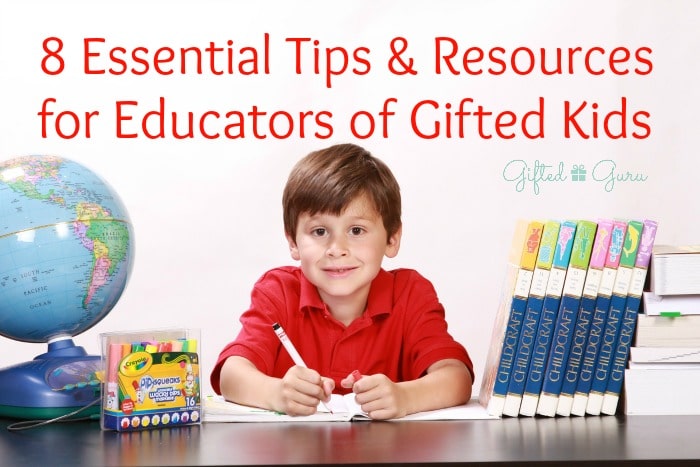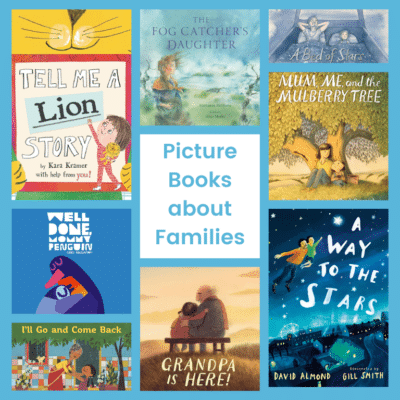Educators need specific resources and strategies for teaching gifted kids, and I could (and do) spend days and days on helping them find those resources an develop those strategies. (See my Speaking page for more on that).
This post came about when I received an email from a reader who wrote in part:
Dear Lisa,
I love love love your page and all the support you are giving to the gifted community [Okay, so maybe I didn’t have to keep that part in, but it was so nice, don’t you think?]. I have a maybe unusual situation but believe you have probably some ideas to help.
I have a gifted 7yr old who is just finishing 1st grade. Her teachers have recognized that she does not fit the mold, and since they can’t skip her, are looking for ways to challenge her and provide enrichment for her. They are genuinely open to suggestions but admit they have no experience to draw from.
A Reader
Now some of you parents who have not encountered this type of teacher before (see Why School’s Not Fair to Gifted Kids) may want to pause and just think about this. I know I did a little “She’s so lucky!” dance.
If you’re new to gifted as an educator, you need to find the essential resources to get you started. If you just start poking around, you can easily become overwhelmed by the {amazing but} impossible-to-process amount of information available.
So I’m going to share (in no particular order) what I believe to be the most essential resources & tips you need, why you need them, and what to do with them.
If you’re an educator, thank you so much for caring about gifted kids enough to spend your precious time preparing to better teach them.
1. The Institute for Research and Policy on Acceleration.
Why you need it:
Too many educators think of acceleration as an all-or-nothing proposition in which some tiny little socially awkward and too-dressed-up kid skips three grades and goes to school in a den of big kid lions, becoming Doogie Howser and missing every joy of childhood.
Nothing could be further from the truth. Do you remember the opening scene of the Fellowship of the Ring when Galadriel says, “But they were all of them deceived”? It’s like that. Educators are deceived about acceleration.
Acceleration takes many forms, and even its most adamant opponents don’t argue against its most common iteration: Advanced Placement.
This site offers the best research in acceleration (far better than anecdotal stories in manner of labor horror stories mean people tell), information about its methods and pedagogy, and ways to incorporate it even in schools where it’s not an actual policy.
What to do with it:
- download and read A Nation Deceived and become an acceleration convert.
- consider ways (even micro-ways) you can incorporate some acceleration in your classroom. For example, can the child work with students from another grade on a single project? Can the child take an online MOOC class? Can you let the child (gasp!) read ahead?
2. Byrdseedgifted
Why you need it:
Because Ian Byrd is one of the best and most genius voices in gifted education today, and his website shares practical, drag-and-drop tips. His lesson suggestions include ideas for teaching the way gifted kids think. He is a teacher’s teacher, a gifted grown-up still in touch with his inner gifted kid, and you could find no better internet mentor or model than Ian.
In the interest of full disclosure, Ian and I are friends, and I’m connected with his Byrdseed TV, but we’re friends because he’s spectacular. I was singing his praises long before I ever met him.
What to do with it:
- subscribe to his newsletter
- sign up for a month of Byrdseed TV. For the cost of a venti chocolate chip Frappuccino, you can learn a lot of practical tips from real educators like you.
- if you’re a social media person, follow him on Facebook and/or Twitter.
3. Supporting the Emotional Needs of the Gifted (SENG)
Why you need it:
SENG is your portal to quality information about the affective domain. They offer SENGinars, and lots of free online reading to help you understand exactly what is making that kiddo tick.
You will never fully meet the needs of gifted youth unless you understand the way they think and feel and how that differs in distinct ways from typical learners.
What to do with it:
- browse their resource library
- sign up for a SENGinar (you can all watch together, so sign up the school and have a watching party)
4. Let student interest drive the train.
Why you need it:
Interest allows learning extension to be a lure rather than a push. Find out what the child is interested in, and then guide exploration of that topic during the time the rest of the class is working on already-mastered material.
It is poor pedagogy to punish children for giftedness by making them do more of the same work. This is not a strategy; it is surrender. It is guaranteed to drive a love of learning out of even the most joyful of students. If you do nothing else, stop this archaic and indefensible practice.
Independent research projects and project-based learning (alone or in small clusters of gifted students) about things that interest them will make you their fave teacher ever.
You can learn more at Edutopia, in Todd Stanley’s book Project-Based Learning for Gifted Students, and the LearnPBL website. Compare PBL sites before you spend a lot of time browsing useless sites.
What to do with it:
- Don’t spend all your time on this. Send the kids on a learning adventure to find and complete a project that speaks to them.
- Read at least a couple of articles on PBL and think of three ways you can use it in your classroom to better serve your gifted kids.
5. Follow the right people.
Why you need it:
There are people who invest a lot of time in best practices of the gifted. You don’t need to reinvent the wheel – just find them.
They will help you find more resources, save you time, and answer questions. They will be your team, a professional learning community that helps you serve gifted kids better, and, I the end, your friends in meaningful ways.
You simply cannot do it all, and you could spend a lot of time trying to figure out how. Rely on other educators and even those outside education to keep your mind and classroom fresh.
The list below will get you started. Add on only as time and energy permits. It’s better to follow five people with great ideas than 1,000 people who don’t really help. In fact, a great Twitter strategy is to only follow seven or eight people. You will never overwhelm yourself.
What to do with it:
- Find your medium. Are you a Facebook person? Twitter? Pinterest? Whatever works for you, do that. Don’t add “Must change social media habits” to your to-do list. It’s not necessary. So which one do you like best? Stick with that one.
- For Facebook, connect with
Ginger Lewman (Even more spectacular on Twitter, and a real PBL expert)
GiftedGuru (that’s me!)
- For Twitter, follow
@gifted_guru (that’s me, too!)
@Coffeechugbooks (visit his site, too – I love, love, love this guy).
- Create a separate account just for GT ideas and keep that feed pure. You could start an account with only these people, and you would be full of ideas.
- For Pinterest, all you need for GT is BrightKids.
- Once you’re ready to add on, go see who the people you are following follow. That’s a great place to start to add to your virtual team.
6. Library of Congress
Why you need it:
The Library of Congress (affectionately known as the Mother Ship) is the THE resource for teachers of the gifted. Start at their teacher page and never look back.
From information on how to use primary source documents (they’ll need this for their research projects), to webcasts of authors from the National Book Festival, to fantastic lists of books, to lesson plans you can search by standards, you will find what you need to meet the needs of the most cognitively greedy of any student possible.
What to do with it:
- Take some of their self-paced online training for free.
- Explore the evergreen resources of the National Book Festival (Great idea: have students host a book festival on your campus – the site shares how)
- Have students explore the site and its companion Read.gov for hours.
7. Mensa for Kids
Why you need it:
This isn’t on the list just because I work at Mensa, promise. The lesson plans, TED Connections, and other resources are just terrific. American Mensa is a sanctuary for gifted kids and adults (including a billion people in my family – although perhaps I’m somewhat given to hyperbole).
Home to the Mensa Foundation’s truly amazing Excellence in Reading program, the site offers young readers the opportunity to connect with spectacular literature that stays appropriate, no matter the lexile.
TED Connections are perfect for GT students because they can be discussion or written response. TED talks that are appropriate for students are augmented with high-level thinking questions and extension activities and resources.
They are created by teacher request, so if you have a topic you want a lesson plan on, or a TED talk you think merits a TED Connection, email them and share your idea.
What to do with it:
- Explore the lesson plans. They’re designed to be done by a student without a teacher, so they are easy peasy.
- Challenge a student (or yourself) to complete a level of the Excellence in Reading Program.
- Use a TED Connection to create a vibrant class discussion.
8. The Smithsonian
Why you need it:
This is the teacher section of America’s attic. You can get lesson plans, resources, virtual tours, science webcasts, and on and on. You cannot help but love it, and it’s safe to send students there, which makes it even more amazing. Their tagline is “Seriously amazing,” and that is not hyperbole.
You could literally just use this site to let students explore and learn. Don’t worry about the right grade level. GT kids are kind of like self-leveling cement – they’ll find their level if you leave them alone. Caveat: you may not always like it!
What to do with it:
- Quit your job and read the site. Just kidding. Kind of.
- Visit the Qrius site and find two things your students would be interested in.
- The National Zoo is part of the Smithsonian, so be sure to check out its cool online resources, like the animal webcams. My fave? The Naked Mole Rat Cam, of course. There’s just something about seeing the phrase “Playing Naked Mole Rat Live” that I love.
So there you have them – 8 tips & resources to get you started.
You’ll find that they are somewhat of a rabbit hole that will lead you further into Giftedland, but I promise that you’ll love the journey.
If you don’t see a top-tier resource or great person to follow here, please share in the comments!





